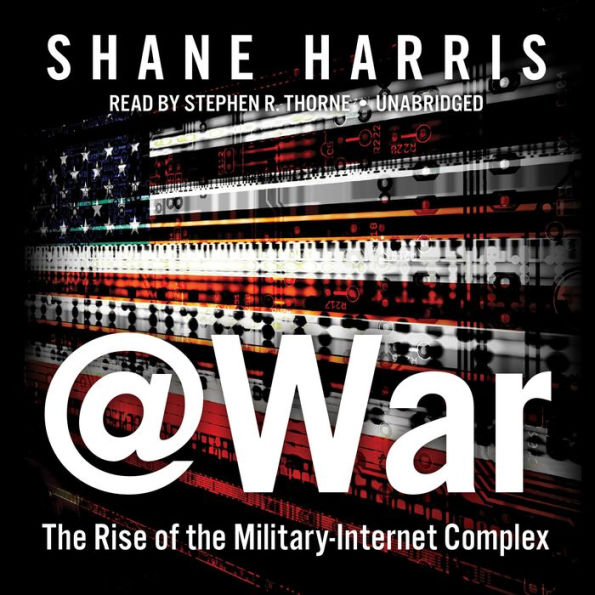Washington Post "Chilling . . . Extraordinary and urgent."Christian Science Monitor "Unsettling . . . Deeply informative."James Risen, author of Pay Any Price: Greed, Power, and Endless War “@War is a remarkable achievement. Harris uses dogged shoe-leather reporting to take us deep inside the government’s surveillance and cyber operations to give an unsparing look at what the NSA and other agencies are really doing with all our data. In the age of abstract Snowden documents, @War actually introduces us to the people running America’s electronic spying machine, and offers invaluable insights into how their ambition and turf battles impact our financial security, our privacy, and our freedom.”Thomas E. Ricks, author of Fiasco and The Generals “A great overview of our new cyberfronts. Unlike most books about cyberwar, this one is enjoyably readable. At times it feels like a modern spy novel, but it is a guide to tomorrow’s headlines.”Peter Bergen, author of Manhunt: The Ten-Year Search for Bin Laden from 9/11 to Abbottabad “@War is a tour de force of reporting on the past, present, and future of cyber-conflict. It will be required reading both in the Pentagon and among the army of Chinese cyber spies now assaulting American businesses. Hackers, policy makers, and others will find this book both intriguing and alarming; not to mention very well written.”Publishers Weekly "Cyber-espionage is the 'single most productive means of gathering information about our country’s adversaries,' writes Harris (The Watchers: The Rise of America’s Surveillance State), senior writer for Foreign Policy, in this unnerving exposé. After 9/11, the National Security Administration (NSA), the nation’s global information-gathering agency, submitted a wish list to the Bush administration. It was approved and the “'military-Internet complex was born.' According to Harris, electronic eavesdropping was fundamental to 2007’s Iraq surge and the NSA located Osama bin Laden through spyware planted in his operatives’ mobile phones. Readers will squirm as they learn how every communications enterprise (Google, AT&T, Verizon, Facebook) cooperates with the national security establishment. Harris delivers a convincing account of the terrible cyberdisasters that loom, and the intrusive nature of the fight to prevent them."Kirkus Reviews "Sprawling account of how the U.S. military joined forces with the National Security Agency to develop 'cyber warfare' capabilities, monitoring America's enemies and its citizens alike. Harris adeptly documents the online threats directed at American society, ranging from the Chinese military's well-funded hacking cells to large-scale information thefts committed by international crime syndicates, but he also demonstrates the NSA's insatiable collection of metadata and preparation of "backdoor" cyberweapons for future use, concluding that '[a]nonymity and collective security may be incompatible in cyberspace.'"
A surprising, page-turning account of how the wars of the future are already being fought today
The United States military currently views cyberspace as the "fifth domain" of warfare-alongside land, sea, air, and space-and the Department of Defense, National Security Agency, and CIA all field teams of hackers who can-and do-launch computer virus strikes against enemy targets. In fact, as @War shows, US hackers were crucial to our victory in Iraq.
Shane Harris delves into the front lines of America's new cyberwar. As recent revelations have shown, government agencies are joining with tech giants like Google and Facebook to collect vast amounts of information. The military has also formed a new alliance with tech and finance companies to patrol cyberspace, and Harris offers a deeper glimpse into this partnership than we have ever seen before. Finally, Harris explains what the new cybersecurity regime means for all of us who spend our daily lives bound to the Internet-and are vulnerable to its dangers.
A surprising, page-turning account of how the wars of the future are already being fought today
The United States military currently views cyberspace as the "fifth domain" of warfare-alongside land, sea, air, and space-and the Department of Defense, National Security Agency, and CIA all field teams of hackers who can-and do-launch computer virus strikes against enemy targets. In fact, as @War shows, US hackers were crucial to our victory in Iraq.
Shane Harris delves into the front lines of America's new cyberwar. As recent revelations have shown, government agencies are joining with tech giants like Google and Facebook to collect vast amounts of information. The military has also formed a new alliance with tech and finance companies to patrol cyberspace, and Harris offers a deeper glimpse into this partnership than we have ever seen before. Finally, Harris explains what the new cybersecurity regime means for all of us who spend our daily lives bound to the Internet-and are vulnerable to its dangers.

Editorial Reviews
Product Details
| BN ID: | 2940169869460 |
|---|---|
| Publisher: | Blackstone Audio, Inc. |
| Publication date: | 11/11/2014 |
| Edition description: | Unabridged |
Videos


